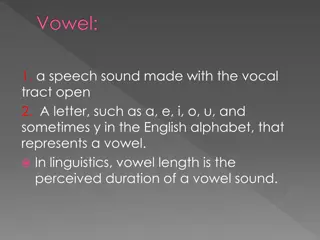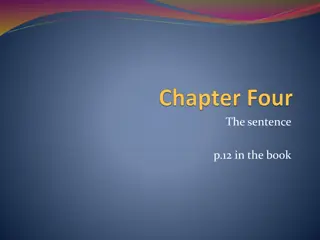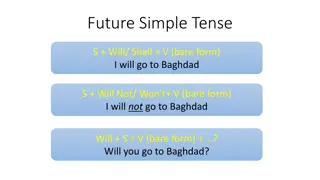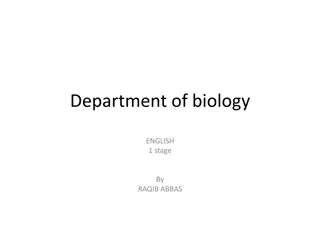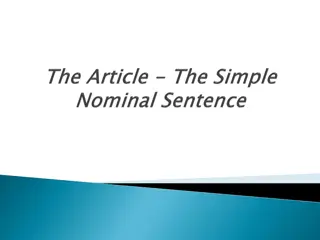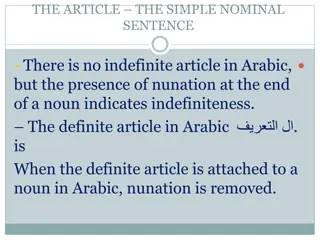Understanding Verbal Categories of Tense in English and Arabic
Verbs in English and Arabic exhibit tense distinctions with different forms denoting past and present time. English has two tenses - past and present, marked by suffixes, while Arabic has perfect and imperfect tenses marked by suffixes, prefixes, and internal vowel changes. Contrasts include English's third-person singular verb suffix and Arabic's use of prefixes and suffixes across all verb forms.
Download Presentation

Please find below an Image/Link to download the presentation.
The content on the website is provided AS IS for your information and personal use only. It may not be sold, licensed, or shared on other websites without obtaining consent from the author. Download presentation by click this link. If you encounter any issues during the download, it is possible that the publisher has removed the file from their server.
E N D
Presentation Transcript
THE VERBAL THE VERBAL CATEGORIES OF TENSE, CATEGORIES OF TENSE, ASPECT & VOICE ASPECT & VOICE
Tense Tense Verbs exhibit tense distinctions. Verbs exhibit tense distinctions. That is, they have different forms That is, they have different forms that denote semantic notions that denote semantic notions such as past and present time. such as past and present time.
( (i i) English ) English Morphologically, English has two tenses: Morphologically, English has two tenses: past and present past and present. . The present tense The present tense inflectional suffix is inflectional suffix is - -s which appears with s which appears with the third person singular regular verb the third person singular regular verb, e.g., write write- -s, play s, play- -s, watch s, watch- -es. inflectional suffix is inflectional suffix is - -ed ed, e.g. play , e.g., es. The past tense past tense , e.g. play- -ed, like ed, like- -d. d.
(ii) Arabic (ii) Arabic Arabic Arabic has two tenses: has two tenses: past or perfect and perfect and present or imperfect. present or imperfect. The past verb is marked by suffixes The past verb is marked by suffixes, , whereas whereas the present verb is marked by the present verb is marked by both prefixes , suffixes and internal both prefixes , suffixes and internal vowel change vowel change past or
katab- -a a Perfect: Perfect: katab ( (ADDING A SUFFIX) ADDING A SUFFIX) Imperfect: ya-ktub-u 1. ADDING A PREFIX INTERNAL VOWEL CHANGE 3. ADDING A SUFFIX 2.
CONTRAST CONTRAST First First: both English tenses are marked by suffixes, : both English tenses are marked by suffixes, whereas Arabic imperfect tense is marked by prefixes , whereas Arabic imperfect tense is marked by prefixes , suffixes and internal change. suffixes and internal change. Second Second: the English present tense suffix is added only : the English present tense suffix is added only to third person singular verbs, whereas the Arabic to third person singular verbs, whereas the Arabic imperfect prefixes and suffixes are added to all forms of imperfect prefixes and suffixes are added to all forms of verbs in their person and number distinctions. verbs in their person and number distinctions.
Verbs also exhibit aspect Verbs also exhibit aspect distinctions. These are distinctions. These are semantic distinctions that semantic distinctions that relate the verb action to relate the verb action to the moment of speaking. the moment of speaking.
English has two aspects: English has two aspects: perfective progressive progressive. The perfective indicates . The perfective indicates "anterior time" and portrays the action "anterior time" and portrays the action as being complete, whereas the as being complete, whereas the progressive indicates "simultaneous progressive indicates "simultaneous time" and portrays the action as being time" and portrays the action as being in progress at a given time in progress at a given time. perfective and and
The perfective is marked by the The perfective is marked by the auxiliary HAVE plus the auxiliary HAVE plus the - -ed/ participle of the verb participle of the verb, e.g., John John. The progressive, on the other . The progressive, on the other hand, is marked by hand, is marked by the auxiliary BE plus the auxiliary BE plus the the - -ing ing participle form of the verb participle form of the verb, e.g., He is writing a letter He is writing a letter. . ed/- -en I have seen en , e.g., I have seen , e.g.,
Morphology of Arabic Tense and Aspect Morphology of Arabic Tense and Aspect The ancient Arab grammarians divided verbs into three types on the basis of morphological formation: (1) past /perfect: wrote (2) present /imperfect yaktubu He writes (3) imperative: kataba He uktub write
*The Arabic verb has two tenses: The Arabic verb has two tenses: 'perfect' and perfect' and imperfect *The perfect refers to past time while *The perfect refers to past time while the imperfect can typically refer to the imperfect can typically refer to present or future time. present or future time. *The two tenses, together with *The two tenses, together with particles, express the various aspectual particles, express the various aspectual meanings meanings imperfect
*Perfect tense indicates perfective *Perfect tense indicates perfective aspect and imperfect tense indicates aspect and imperfect tense indicates imperfective aspect. imperfective aspect. * *Perfective aspect indicates a Perfective aspect indicates a completed action completed action, e.g., , e.g., he talked, while while imperfective aspect indicates imperfective aspect indicates non non- -completed action completed action, e.g., was talking. was talking. he talked, , e.g., he he
Arabic has two aspects: perfective and imperfective. These are realized by the perfect and imperfect tenses, respectively. Perfective: `The teacher arrived.' Imperfective: 'The boy studies every day.' The perfective can also be realized by the particle qad followed by the perfect, e.g., `The boy has written the lesson.'
CONTRAST CONTRAST First First: the English perfective is realized by : the English perfective is realized by have+ed have+ed participle, whereas the Arabic participle, whereas the Arabic perfective is realized by either the perfect perfective is realized by either the perfect form of the verb or form of the verb or qad+perfect Second Second: the English progressive aspect is : the English progressive aspect is rendered in Arabic by the imperfect form of rendered in Arabic by the imperfect form of the verb. the verb. qad+perfect. .
THE VERBAL CATEGORY OF THE VERBAL CATEGORY OF VOICE VOICE
( (i i) English ) English active and passive. The passive is English has two voices: English has two voices: active and passive realized by a complex verb phrase that consists of realized by a complex verb phrase that consists of be+ed participle. participle. Active: She typed the letter yesterday. Active: She typed the letter yesterday. Passive: The letter was typed yesterday. Passive: The letter was typed yesterday. The object of the active sentence becomes the subject of The object of the active sentence becomes the subject of the passive counterpart, and the auxiliary verb BE and the the passive counterpart, and the auxiliary verb BE and the passive participle are added to the passive sentence passive participle are added to the passive sentence. . . The passive is be+ed
(ii) Arabic (ii) Arabic Arabic verbs have active and passive forms. The Arabic verbs have active and passive forms. The passive forms are formed from the active forms passive forms are formed from the active forms by by internal vocalic change internal vocalic change. For example, the active verb active verb he wrote becomes he wrote becomes was written in the passive. Other examples are: in the passive. Other examples are: He said He said It was said He invited' He invited' He was invited . For example, the was written It was said He was invited
CONTRAST CONTRAST In Arabic the active form of the verb is made In Arabic the active form of the verb is made passive by internal vocalic change, whereas in passive by internal vocalic change, whereas in English the active form of the verb is made English the active form of the verb is made passive by changing it into the passive by changing it into the - -ed participle and by introducing the appropriate form of "be". by introducing the appropriate form of "be". ed participle and










